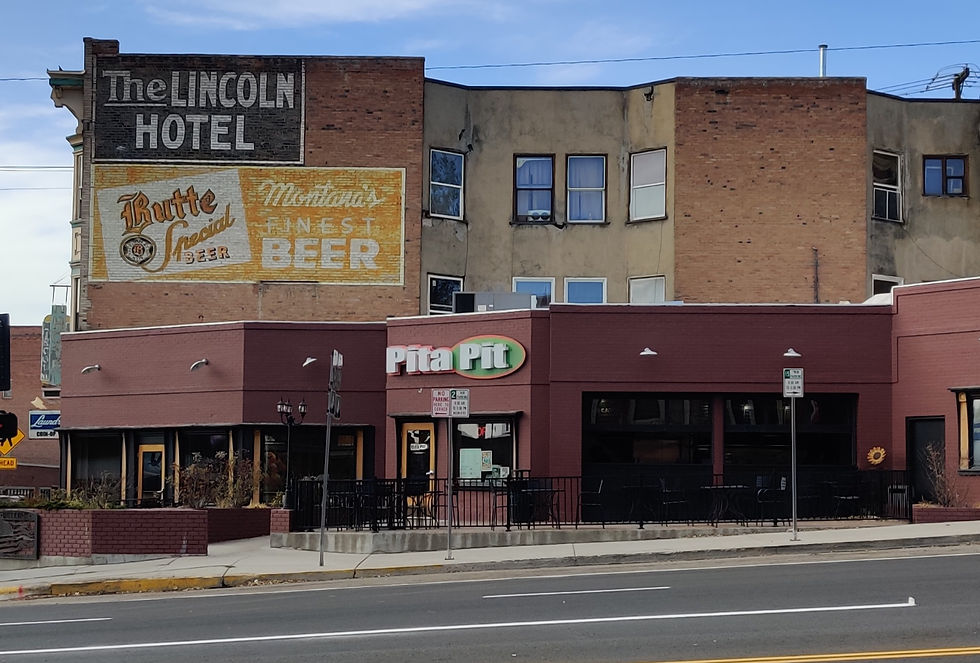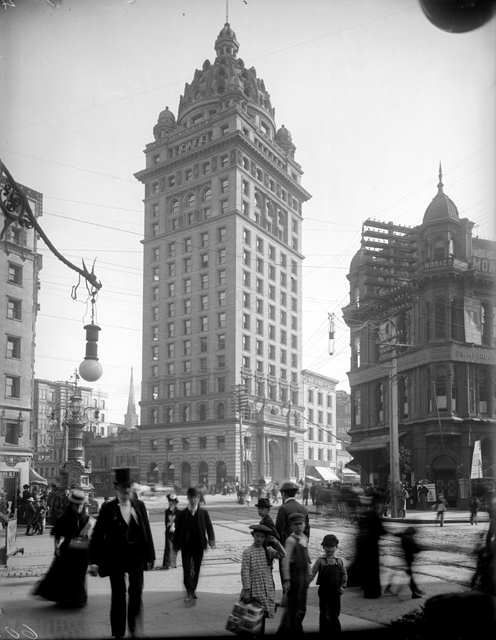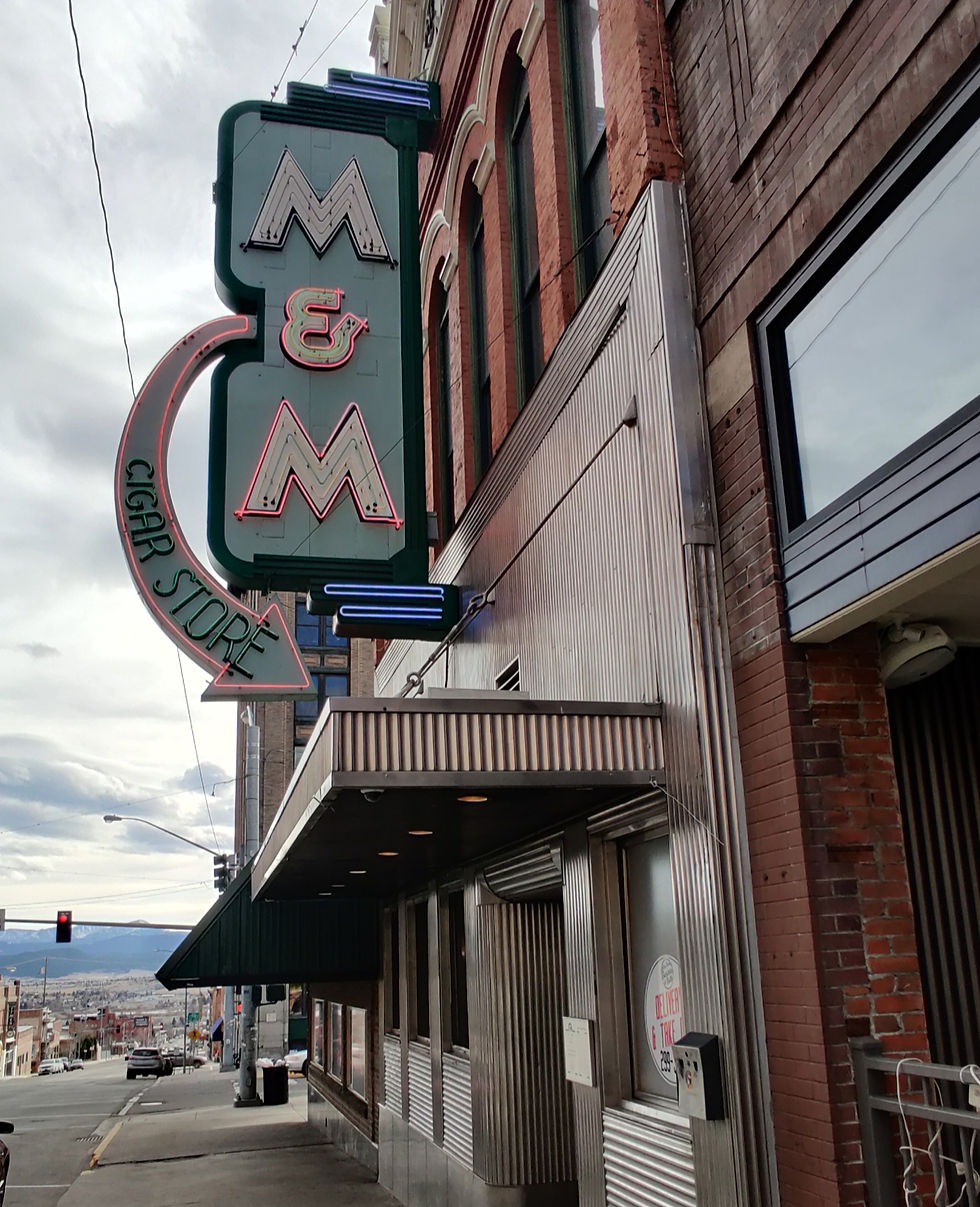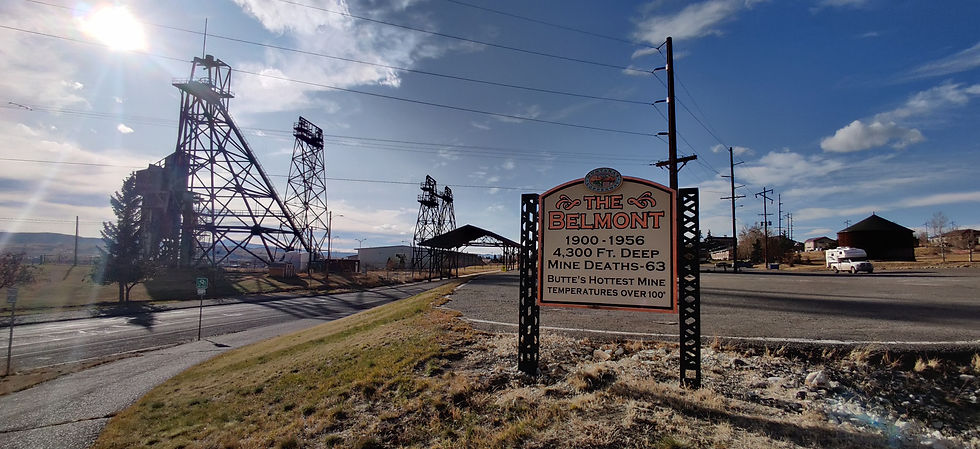Ireland's Fifth Province in the American West
It's a town that stands out from afar, elevated upon its earthen perch, guarded by a watchman of the past, the head frame of the Original Mine. Even from the interstate, one can see right up "The Hill" down Main Street, Butte, with its grand Victorian architecture, into the place once referred to as the "Fifth Province of Ireland." At the turn of the 19th century, Montana boasted one of the largest Irish populations in the United States, and Butte in particular was nearly 25% Irish. Along with the Irish, many other men and women from around the globe converged on Butte during its long history of mining copper, silver, and gold throughout the thousands and thousands of miles of tunnels running beneath its streets. Among these dreamers were also plenty of architects ready to leave their mark on the American West.
Parking near the 10-story Hotel Finlen, topped with its grandiose three-dimensional sign of white letters by day and rosy-red glowing neon by night, informing the whole valley of its presence, I began my urban trek. Just down the street was a brick warehouse with large, multi-panned windows across its front that I had driven past on my way in. It turned out to be the Butte Carriage Works, which still had paint all over its weather-worn walls, advertising what services it offered for carriages and automobiles alike. The shop had clearly stuck around through the turn of the century and had begun to make the full transition to automobile service. What a ride that must've been for the wheelwrights, blacksmiths, and carpenters of the day. They'd made the transition from working on simple wood and iron wagons that had been around for millennia to fixing the loud, temperamental, smoke-belching engines of the new era after the second Industrial Revolution.

Those pigments adorning the carriage works were the first of many old marketing tools of the old era I would see over the next few hours. They're the kind seldom represented today, hand-laid over a large area on the street side of buildings with a once bright multitude of colors meant to catch the eye from blocks away. As seen above, an advertisement from Butte Brewing Company is still fairly bright and well legible on the building's wall, although the company closed its doors well over half a century ago. These advertisements can be seen in many other cities across the country, but they seem to hang around much longer in the northern Rockies, where things take awhile to catch up to the speed of modern life.
Heading towards downtown, I passed the Curtis Music Hall, with its turret-style corner nook as well as arched and keyhole-shaped windows surrounded by brilliant red brick. Each window is adorned with carved stone accents just below the roof line, the classic accoutrements of the Victorian style. The building was built in 1892 in the Queen-Anne style by an Irishman named John H. Curtis, who was a lawyer as well as a businessman. It was used for a multitude of purposes, including a theater, saloon, and boarding house. Gamer's Confectionary remodeled the building's ground floor in 1933 and moved in. The business was sold in 1949 and evolved into a soda fountain and then a full restaurant.
Scanning my surroundings, I almost didn't feel like I was in Montana. The number of tall buildings was surprising for a city that far into the northern rockies. One is used to being able to see the horizon and the mountains in multiple directions when walking down a Montana main street, but Butte offers only one in many spots. These buildings were some of the first skyscrapers in the definition of the time out west, meaning structures constructed of steel girders to allow heights higher than a handful of stories. In fact, the Hirbour Tower in Butte, an eight-story building constructed in 1901, was considered the second-ever skyscraper built west of the Mississippi. The first was the striking Call Building in San Francisco, with its ornate dome and spire.

Call Building: pre-1938 Renovation Image courtesy of the CTBUH
Continuing on into the heart of the city, crossing Main Street, and sticking to my eastern heading, I passed by multiple well-known landmarks, including the Copper King Mansion. Built in the Roman Revivalist style for William Andrews Clark in the 1880's, the mansion included thick masonry, esteemed entrances, as well as arches over many of the doors and windows in a light stone to contrast the brick. It still stands tall on Granite Street and functions today as a bed and breakfast, providing tours as well. Walking up, I was dismayed to find that tours required a reservation, so I kept on walking.
Ambling down the sidewalks, I directed my gaze this way and that in an attempt to take in all the ornate details of the buildings that made up the city on the hill. Since many of the buildings in Butte were the spawn of the Gilded Age, their architects often spared no expense. They made sure that the windows and doors all sported some sort of flair, including ornate gables, bay windows, specialty shaped-turrets, and more. Even across from the mansion was a nice two-story red brick Victorian with ornately trimmed eaves up top. A fairly normal-sized building today, but styled far beyond 21st-century standards.
Passing more walls of brick of all hues, a pair of apartment structures further east sported finely designed symbols and patterns in the stonework of their upper reaches. One showed off its corner curved glass windows, wrought iron twisting balcony railings, and an intricate stone crest with a lion's head leaping out hung on the walls between the tallest windows. Next to that, across the street, was an imposing government building. It was a light-colored sandstone on the first floor, taken over by brick and more. All three stories were trimmed up with various details etched into the rock. The building was clearly grand, and I didn't find out until later what it was.
Built in 1912 in the extravagant Beaux-Arts style, the Butte-Silver Bow County Courthouse had a storied history. When it was just a couple years old, the structure was briefly used as barracks when martial law was declared during labor riots in 1914. Then the structure served as the backdrop for a handful of prominent political speakers, including Williams Jennings Bryan and Franklin D. Roosevelt. The place had its various rooms and offices laid out around a central rotunda capped with a dome of vibrant stained glass. Details include copper doors, terra cotta lions, and a figure of justice carved into the stone at the highest point, front and center.

Across from that was the Carpenters Union Hall, which was one of the most substantial union buildings I had ever seen. Built at the time when Butte was the stronghold of unionism in the west, the hall had been erected in 1906 and ended up hosting a number of the town's big unions all at once. It included large first-floor archways covering the entryway, along with accompanying arches far up on the windows, surrounded by brick. Small details, including union symbols, smattered the building strategically as well. Just down the street was the grandest of the bunch, the Butte Water Company building, with its large flagpole holding it up tall and proud. Built in 1907, it matches the Beaux-Arts style of the courthouse with those roman columns.
I kept going past many more buildings constructed with fine materials and ornate detail. It occurred to me that not many cities in the US were so true to their architectural roots from 120 years ago. It seemed that large-scale modern development was nearly nonexistent, leaving behind a colorfully detailed city styled in the golden days of the prior century. Some of the vehicles were nearly from that era as well, I soon realized, as a lowered early 1930's truck front cab with a mid-90s Isuzu SUV rear half cruised down Main Street in front of my eyes, motor whining out the tailpipe.

At one point, I got a look down Main Street, running down the hill like an asphalt slide, spreading out layers of mountain before me, sitting mere minutes outside of town across the short valley. It was a constant reminder, even in that urban place, of how brief this all is. The mountains remain for many millennia, and then longer than that. They are the constant while human action and most consequences are mere grains of sand, if even that. Those kinds of reminders are what many people need these days, since they are too far separated from what is natural and the humbling presence that comes with it.
I kept seeing the advertisements all around town, and it made me wonder about the sales of those ad spots back in the day. What did the terms have to be for it to be worth sending a couple people up, suspended on the slick brick face, whipping a paintbrush back and forth, to fill giant letters with colorful paint? Was a year enough, or was the space leased for a decade? Speaking of blank walls, some buildings were also built intentionally without windows on certain sides, not mainly for ads but because some anticipated future skyscraper development on those sides that never came.

Of the many buildings that have been around since the early days, not a whole lot continue to be used for the purpose of their creation. One of these such businesses was the storied M&M "Cigar Store." The place was originally constructed by two gents named Marty and Mosby, and they like to play pool, so the place became a pool hall. All their good friends were having a blast in the place, so it naturally evolved into a bar and then branched out to serve food at some point. The cigar store monkier was adopted along with the 18th Amendment, in order to protect the true identity of the speakeasy in the back of the place. It is said by some that the place was open 24 hours a day, 7 days a week, for over 100 years, and that the owner flushed the keys down the toilet at some point.
The scenes that place must have seen over the changing decades, starting with Montana's first years of statehood and evolving through labor disputes and World Wars. The classic neon sign appears to have gone up in the middle of the last century, at a time when the building next door had a brightly lit "Arcade" sign and other massice glowing vibrant inscriptions beconed patrons through their doors across the city. Multiple generations of men attempted to drown their livers at its bar-top, sitting upon the stools at the M&M. Serving food and drink up through the 1990's, the place finally closed before the new millennia arrived. In 2004, Bud Walker purchased the building, restored it with his son because of the fond memories they had there, and reopened it to the public the next year. M&M continued operating under new ownership until disaster struck just a few short years ago.

On the morning of May 7th, 2021, a fire broke out in the historic brewery and though local firefighters gave it their all, trying to save the place, the flames turned most of the history to ash, requiring that the remains be demolished. The current owner, Selina Pankovich, was so determined that she made sure that the fire was only the beginning of the next evolution of M&Ms, not the final chapter. Opening in February 2023, the new M&Ms operates right next door to the old location today, and business is indeed booming. Pankovich says, "We're doing almost twice as much business; we have 12 more staff than we had at the other location," and has plans to rebuild in the exact same location next door sometime on the horizon.
Right around the corner from the M&M mere feet away lies the Metals Bank & Trust skyscraper. With its copper-adorned entryway, African mahogany window frames, and marble-walled lobby, it's clear that copper king financier F. Augustus Heinze wanted to demonstrate Butte's turn-of-the century wealth to those far and wide. The great architect, Cass Gilbert, drew up the blueprints for the building itself. Gilbert is mainly known for designing the Woolworth Building in New York City, the Supreme Court Building in Washington, DC, and a few state capitols. The name of the place was spelled out with oxidized metal letters fixed into the faded tan stone across the front. An old burglar alarm shaped like a mini jukebox hung off the corner at Park and Main Streets, likely as old as the building itself.
After walking a bit further east to Wyoming Street, past the Dumas Brothel, which had closed only forty or so years ago in 1982, I arrived at the remains of the Belmont Mine. There was a massive iron headframe towering high into the sky, flanked by smaller yet similarly stout iron towers that helped support the cables that ran from the nearby engine house to power the pulleys, which would lift men and materials up and out of the dark, fiery depths. I'm nearly speaking literally, since the Belmont was well known to be the hottest mine around town, with temperatures in the triple digits down there, nearly a mile underneath the surface of the hill.

In the photo above, the large hoist house is off-frame to the right, spaced out, in order for the angle to be correct for the cables. The structure was home to massive steam and later electric motors that turned the winches to raise and lower the cables over the head frame's pullies and into the mineshaft to lift men and material back out again. The hoist house is still in good condition these days and now houses the Belmont Senior Center. Built of brick with large arched windows multiplied across its walls, I was glad that the building had been repurposed for modern-day use. The large roof that now sits to the left of the sign above was designed to shield railcars and others crossing under the cables from the gargantuan gobs of grease that inevitably fell as the beaming summer sun would heat up the sky locked steel sinews.
Behind me at that moment was the Berkley Pit, which now encompasses most of the eastern part of Butte. The toxic "lake" began taking shape back in the 1950's as the first truck serviced open-pit copper mine in Butte. Slowly but surely, all the underground mine workings of the city were phased out by the early 1980's, and men no longer descended into the earth with their lives hanging in the balance on a bunch of tiny strands wound together. The Anaconda Company continually bought up plots of land and a few whole neighborhoods on the east side of Butte in order to keep expanding the pit. Trucking ore up and out of the earth on tiered levels cut into the rock with massive shovel machines, the mine grew narrower and deeper until 1982, when the good stuff was gone and the place was officially mined out.
Up until that point, the Atlanta Richfield Company, known as ARCO, had been pumping water out of the pit for the last several years since it had acquired the mine from the Anaconda Company in 1977. Then, in 1982, the decision was made to shut off the pumps and cease mining operations, so the water began to rise. Today, the water level rise has stagnated significantly after peaking about five years ago, thanks to efforts to pump and treat the highly acidic heavy metal-laden water through multiple facilities before emptying it back into the environment.
With the popularity of EVs growing and growing, the global demand for copper has skyrocketed in recent years. Perhaps the former "Richest hill on Earth" may yet get another shot at mining glory. Or, more likely, those days have faded for good, leaving behind a storied history of sweat and sacrifice to help supply the raw materials of American industry during the 20th century.
Sources:
The Montana National Register Sign Program, “Curtis Music Hall,” Historic Montana, accessed May 26, 2024, https://historicmt.org/items/show/2027.
Gibson, Richard. “Hirbour Tower, 102 N. Main.” Hirbour Tower, 102 N. Main, Awesome Inc, 7 Mar. 2013, butte-anacondanhld.blogspot.com/2013/03/hirbour-tower-102-n-main.html. Accessed 25 May 2024.
Megan Nolan, Northern Arizona University
, “The Copper King Mansion,” Intermountain Histories, accessed June 5, 2024, https://www.intermountainhistories.org/items/show/233
The Montana National Register Sign Program, “Silver Bow County Courthouse,” Historic Montana, accessed June 6, 2024, https://historicmt.org/items/show/1937.
“Government Buildings: City and County of Butte-Silver Bow, MT.” Government Buildings | City and County of Butte-Silver Bow, MT, Butte-Silver Bow County, www.co.silverbow.mt.us/186/Government-Buildings. Accessed 05 June 2024.
The Montana National Register Sign Program, “Carpenter's Union Hall,”Historic Montana, accessed June 6, 2024,https://historicmt.org/items/show/1938.
Montana Historical Society, “Butte Water Company,” Story of Butte, accessed June 6, 2024, https://storyofbutte.org/items/show/1935.
“The Last Great Cigar Store: The History of the M&M.” KXLF News, 7 May 2021, www.kxlf.com/news/local-news/the-last-great-cigar-store-the-history-of-the-m-m. Accessed 05 June 2024.
Emeigh, J. (2024a, May 8). Butte’s M&M thriving three years after fire destroyed iconic original location. KXLF News. https://www.kxlf.com/news/local-news/buttes-m-m-thriving-three-years-after-fire-destroyed-iconic-original-location
Gibson, Dick. “Butte, America’s Story Episode 260 - Metals Bank Building.” The Verdigris Project, KBMF/Butte-Silver Bow Public Archives , 11 Nov. 2021, www.verdigrisproject.org/butte-americas-story-blog/butte-americas-story-episode-260-metals-bank-building. Accessed 06 June 2024.
Burmeister, Tim. “After 150 Years, Mining Continues in Butte.” Elko Daily Free Press, 7 July 2023, elkodaily.com/news/local/business/mining/after-150-years-mining-continues-in-butte/article_632f3966-0d8f-11ee-a87b-6b0d854a7bfb.html. Accessed 10 June 2024.


Commentaires